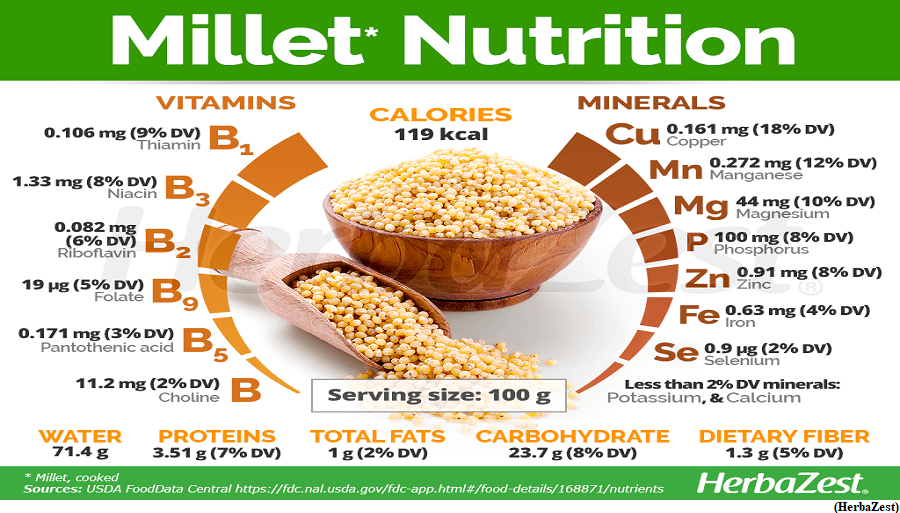The nutritional value of millets (GS Paper 3, Economy)

Context:
- The UN Food and Agriculture Organization (FAO) has declared 2023 to be the ‘International Year of Millets’.
- Millets are becoming more popular in India as well because of their low input requirements and high nutritional density, both of which are valuable for a country whose food security is expected to face significant challenges in the coming decades.
- However, the consumption of millets face one threat that has already overtaken India’s major food crops, grain-processing.
What are millets?
- Millets are fundamentally grasses. They are cultivated worldwide, but especially in the tropical parts of Africa and Asia, as cereal crops.
- Some of the more common varieties include pearl millet (Cenchrus americanus), barnyard millet (Echinochloa utilis), finger millet (Eleusine coracana), and foxtail millet (Setaria italica).
- There is both palaeontological and textual evidence to indicate that millets were being cultivated in the Indian subcontinent five millennia ago.
- According to the Agricultural and Processed Foods Development Authority, India is the world’s largest producer of millets. In 2021-2022, the country accounted for 40.51% of the world’s pearl millet production and 8.09% of sorghum. Within the country, pearl millet made up 60% of all the millet production, sorghum 27%, and ragi 11%.
- Sorghum (Sorghum bicolor), adlay millet (Coix lacryma-jobi), and teff (Eragrostis tef), among others, are grasses that differ in some respects from millets but are grouped together with them.
Why are they sought after?
- Millets have two broad features that render them attractive; their nutritional value being comparable to that of major extant food crops (and better on some counts) and their ability to reliably withstand harsh, resource-poor conditions.
- They are drought-tolerant, adapted to growing in warm weather, and require low moisture (axiomatically, they are particularly efficient consumers of water) and loamy soil. They don’t grow well in water-logged or extremely dry soil which might occur after heavy rainfall or particularly bad droughts, respectively.
- Nonetheless, millets have the upper hand over crops like rice and maize with more drought-like conditions expected in many parts of the world, including the newly realised prospect of ‘flash droughts’.
Are millets nutritious?
- The nutritional content of millets include carbohydrates, proteins, fibre, amino acids, and various minerals. Different millet varieties have different nutrient profiles.
- For example, pearl millet has been found to have higher protein content than rice, maize, and sorghum, while being comparable to that of barley.
- Foxtail millet is rich in the amino acid lysine; finger millet has more crude fibre than wheat and rice; proso millet has a significant amount of the amino acids leucine, isoleucine, and methionine; and overall, millets have been found to be important sources of micronutrients and phytochemicals.
Where are the nutrients stored?
- Each millet kernel consists of three major parts, called pericarp, endosperm, and germ. The pericarp has an outer covering called the husk. The husk and the pericarp together protect the kernel from inhospitable conditions, disease, and physical damage.
- The endosperm is the largest part of the kernel and its ‘storage’ centre. It has a protein covering called the aleurone.
- According to an FAO article about sorghum, the endosperm is “relatively poor in mineral matter, ash and oil content” but “a major contributor to the kernel’s protein (80%), starch (94%) and B-complex vitamins (50-75%)”.
- Similarly, pearl millet has a relatively larger germ, which is “rich in oil (32%), protein (19%) and ash (10.4%),” plus “over 72% of the total mineral matter”.
How does processing affect the nutrients?
- Processing and preparing millets for consumption can affect nutrients in three ways; enhance them, suppress/remove them, and ignore them. In this context, ‘whole grain’ refers to the endosperm, germ, and bran (pericarp + aleurone) whereas ‘refined grain’ refers only to the endosperm.
- The husk is removed from the grains because it is composed of cellulosic matter that the human body cannot digest. But at least one study has found that when this is done to pearl millets, their phytic acid and polyphenol contents drop.
- The second common step is to decorticate the grain, that is, remove any other outer covering and expose the seed. While studies have found that mechanical and hand-worked decortication did not have significant effects on the grain, they both removed crude and dietary fibre.
- But decortication also makes the grain more edible and visually attractive, which are favourable factors when marketing them to urban centres.
- The typical next steps are milling, to grind the grains into flour, and sieving to remove large ‘impurities’, including bran.
What is the effect of polishing?
- A frequent last step is polishing. The longer the grains were milled, the more protein, fat, and fibre contents the process removed. A different 2012 study found that barnyard millet could be polished with a rice polisher for up to three minutes without significant nutrient loss.
- Polishing is the process whereby brown rice, for example, is changed to white rice by rubbing off the bran and the germ.
- A study assessed the effects of polishing in the nutritive value of two major Asian rice varieties ; indica and japonica. Using a combination of precision abrasive polishing, plasma mass spectrometry, and fluorescence microscopy, they found that polishing removed 8-10% of grain weight and also removed 60-80% of iron, magnesium, phosphorus, potassium, and manganese in both varieties. The loss of bran also compromised the grains’ fibre content.
- Yet rice polishing is considered desirable because, as per a 2009 study, most consumers favour the resulting taste and texture and prefer the shorter cooking time, and retailers want longer shelf-life, which can be achieved by removing the bran.


